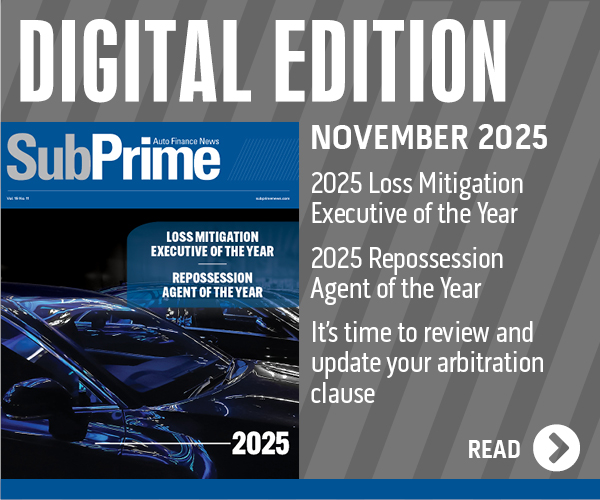Who will absorb potential interest rate rise?

By subscribing, you agree to receive communications from Auto Remarketing and our partners in accordance with our Privacy Policy. We may share your information with select partners and sponsors who may contact you about their products and services. You may unsubscribe at any time.
ALEXANDRIA, Va. –
With an interest rate increase widely expected to be handed out by the Federal Reserve, a quartet of experts gathered by the American International Automobile Dealers Association for a webinar this week touched on what impact the move might have on auto financing.
If an increase of 25 basis points comes from the Fed that’ been widely projected, Richard Kwas described his assessment as “it would have very limited impact on affordability in the near term.
“Later in 2016, if rates were to continue to rise, then it would potentially start to have an impact. Recall though that the OEMs can work various different avenues to maintain affordability,” continued Kwas, who is managing director and senior automotive analyst at Wells Fargo Securities.
After considering what components are in play nowadays in the auto finance space, Kwas surmised where that 25-basis-point climb might land.
“This type of interest rate increase is pretty modest and can be absorbed by the finance provider if they so choose,” Kwas said. “It may not ever show up directly to the consumer at all. We think in the near term it might have very limited impact. It’s kind of wait-and-see approach to see if this movement impacts affordability.”
Keeping that contract affordable for the buyer, of course, has been one of the most influential driver of lengthening loan terms. As of the third quarter, Experian Automotive pegged the average term at 67 months for new-vehicle financing, 63 months for used-vehicle contracts; levels that climbed by a month year-over-year.
Subscribe to Auto Remarketing to stay informed and stay ahead.
By subscribing, you agree to receive communications from Auto Remarketing and our partners in accordance with our Privacy Policy. We may share your information with select partners and sponsors who may contact you about their products and services. You may unsubscribe at any time.
That growing term metric is part of the reason Michael Collins thinks a modest interest rate rise won’t impact auto financing much. Collins is senior vice president of lender and F&I solutions at Dealertrack Technologies.
“I think if we sat down every year for the last 10, we would be talking about when should rates go up and when will rates go up,” Collins told his fellow webinar panelists and attendees. “It’s inevitable that rates have to go up and yet here they are still at all-time lows. I think they’re going to remain reasonably flat. I don’t see what the Fed is talking about as materially impacting the business.
“If you look at auto financing over a very long time horizon, 25 or even 50-point increases don’t materially change what happens in auto retailing,” he continued. “Now dramatic spikes at 50 and above all at once, that could really curtain demand. But a 25-basis point change largely is absorbed by an increase in term. Dealertrack saw an increase in term in both new and used cars by about a month this year. That amount can easily absorb an increase of 25 basis points.
“Competition that’s in all spectrums of credit will probably have a lot lenders having to absorb something as small as a 25 basis point change. I just don’t see that doing very much to the consumer,” Collins went on to say.
As chief economist, Tom Kontos of ADESA Analytical Services offered a little different perspective on what the Fed’s decisions might do to auto financing. Kontos used a festive analogy to begin his assessment.
“The traditional reason for the Fed taking the punch bowl away from our party here by raising rates is concern about inflation,” Kontos said. “Your level of expectation for what kind of level of increase we might see throughout 2016, beyond the quarter-point increase expected this month, depends on your view of inflation.
“Thus far, there have been very little signs of inflation; in fact some signs of deflation,” he continued. “The Fed does have kind of a Catch-22, in trying to signal the end of the party with the need to raise rates. We’re nearing full employment, so there might be wage pressure. That’s an understandable concern that might cause the Fed to make this move in December.”
So if the Fed makes a move as expected, Kontos tackled the questions of what might push the board to take more actions later in 2016.
“Beyond, there has to be more of an indication of inflation. That would have to come from some rebound in oil prices. Unless and until that happens, you can expect that probably any further rate increases would be modest,” Kontos said.
“What impact might that have on the auto industry? Probably not too much,” he continued. “Barring any growth in inflation, I would expect the Fed’s moves to be very conservative and gradual. Later in 2016, you might see another half point, tops.”
Kwas and his colleague from Wells Fargo Securities, David Lim, closed the webinar discussion about interest rates and vehicle financing by elaborating about a point Collins raised. Collins described finance company behavior as “rational” before adding, “I really don’t see anything across the whole spectrum of credit changing behavior. If anything, competition will sometimes allow some crazy things to happen.”
It’s the element of competition that drew attention from Kwas and Lim, who is vice president and equity analyst at Wells Fargo Securities.
“There is really not any indication of a major pullback. If anything in the near term, there might be some incremental willingness to lend more aggressively, which I think done in a disciplined way is not a bad thing,” Kwas said.
“At this point with loss rates across various credit spectrums edging up but still well below the peak, there’s not really a reason for a lender to pull back at this point, particularly with job growth at 200,000 unit mark and above. That’s a pretty solid number. That certainly gives lenders a reason to stay in the market,” he went on to say.
Then Lim immediately chimed in, pointing toward how large, well-established captives and financing companies are doing.
“They’ve been doing this a long time. They know what their loss rates are and what they can do from a lending standpoint. They have very good algorithms in my opinion on what to charge a customer,” Lim said.
“There’s a movement of budgets if you will, especially with OEM lenders where if they want to subsidize a loan, they work with the manufacturer to move around the budget to help the finance company,” he added.


